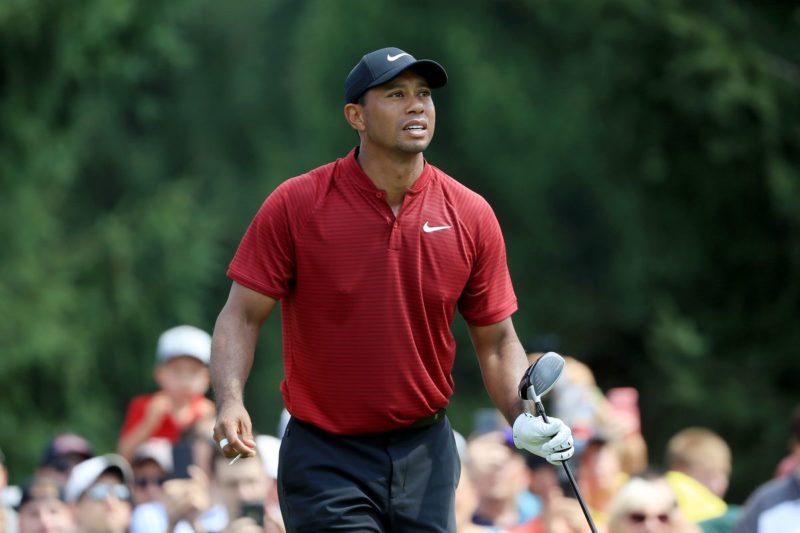Tiger Woods’ masterful performance at Sunday’s PGA Championship final gives fans some of the old magic, but also shows how much the PGA needs a broken pro
The moment he pumped his fist, you knew it was real.
As Tiger Woods finished the 72nd and final hole with a birdie, the crowd at the 2018 PGA Championship shattered the Sunday afternoon air with a cacophony of bellowing cheers that didn’t, for a single moment, betray the fact that Tiger only finished second.
Second place for a man who famously declared such a thing as vile anathema only meant for those who didn’t try hard enough (not exactly his words, but pretty damn close). But after a long stretch where it was unlikely at best that Woods would ever even sniff a top-five performance in a golf major, second place was every bit the sort of moral victory that the Tiger of 2008 would spit on, but the Tiger of 2018, humbled by injury and poor life choices, relished like none other.
And for a sport that seems at times to be on its last legs–with coverage routinely shuffled off from network TV to cable and internet streaming–seeing Tiger in the hunt on a Sunday afternoon feels like a trophy of its own as the very sorts of peripheral viewers, those who never understood or loved golf, but absolutely wanted their Tiger fix found themselves once again looking in and bringing ratings in the door.
This says as much about the allure of Tiger Woods as it does the decline of golf as sport and public entertainment.
While Woods looks pretty good right now, the odds are always going to be against him going forward, something that may be the very spark that drives him to the major championship wins that no one said he could do.
Now one could argue that the “Tiger Bump” was unsustainable, largely because the door that Woods opened–not just for golfers of color, but for young, brash athletes of any race with actual personality and fire–was largely dormant, save for a few mild examples, Rory McIlroy comes to mind, but if you look at the winner of this weekend’s PGA Championship (and compared to Woods’ gallery, not nearly as many did), Brooks Koepka, while talent in the PGA is evergreen, personality simply isn’t.
Koepka, 28, the fifth player to win the U.S. Open and PGA Championship in the same year, joining Woods, Jack Nicklaus, Ben Hogan and Gene Sarazen.
And for all that company, and that achievement, Koepka, who counts Woods as a big reason he picked up the game in the first place, has the personality of a missing person. It’s a shame, too, because Koepka, with raw power and a tank, at 28, that has far more fuel in it than Tiger does at 42, is the type of player with the strength and potential longevity that could lead the Tour for years to come.
Because of its primary locations amongst the verdant greens of sometimes exclusive country clubs, the game of golf will, for the most part, always be seen as a game for the wealthy (and mostly white), but Tiger brought a sense of inclusion, a sense that the game would almost assuredly outstrip the stuffed collar status of its stereotype.
In the 10 years since Woods’ last win, both the game and Tiger himself have suffered. By December 2017, Woods had a dismal rank of 1,199th in the world. The problems inherent with major back surgery, as well as a developed addiction to painkillers threatened to send Tiger into the dustbin of history, a sad cautionary tale that seems to be so indicative of athletes of color when the parades and sponsors all disappear.
However, 2018 is bringing with it a new lease on life for Tiger, and now golf has an opportunity to capitalize once again on its greatest draw since the heyday of Nicklaus. It’s hard to say what the future will hold for a 42-year-old whose back is surgically fused together. While Woods looks pretty good right now, the odds are always going to be against him going forward, something that may be the very spark that drives him to the major championship wins that no one said he could do.
For the game, it’s the life preserver it needs, because all one has to do is listen to the crowds as Tiger came off the tee on Sunday during his remarkable six-under-par day in St. Louis.
Tiger finds a way. 😮#PGAChamp pic.twitter.com/7SXw26F8nM
— PGA of America (@PGA) August 12, 2018
What you hear there is life being breathed back into a PGA that can’t even get most of their Sunday events televised on any of the major networks. Sure there’s cable and there’s the internet as earlier mentioned, but it’s not hard to argue that there’s a difference, and it goes to show how far the game has fallen, as its viewer base ages out in a way that the presence and winning of a younger version of Tiger hoped to stave off.
In the end, the PGA can’t clone another Tiger Woods, and they certainly won’t encourage their other players to ape him either. Tiger’s type of charisma comes only once in a generation in golf (even if it’s a dime-a-dozen in the NBA).
For now, we can only hope for the magic of just one more Sunday jab of the fist, and the roar of a crowd that signifies that our Tiger, battered, bruised, humbled and aged, can go from being on the prowl, to in the hunt and finally pouncing upon a long awaited major tournament championship.
At least one can hope.
Hashim R. Hathaway (Shimbo) is the host of the Never Daunted Radio Network, and proud father to NeverDaunted.Net. You can reach him on Twitter @NeverDauntedNet

